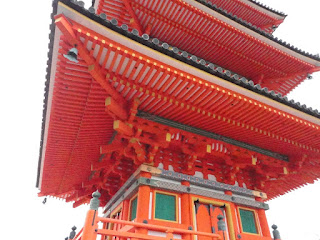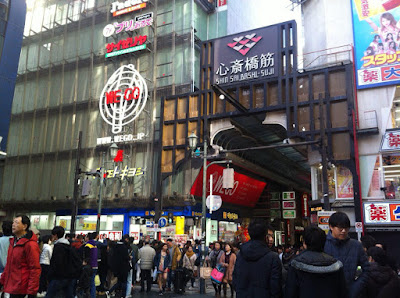All work and no play = a regular day in Japan
If it's one thing that Japanese people know how to do, it's work, and work for long periods at a time with no breaks. Our program is no exception to this concept, as they have tried to cram in as many Japanese cultural events and activities for us to do as possible. Between all my club activities, the full school course load, my
part-time job as an ECO tutor, and the cultural seminars and field trips we
keep going on, I haven’t really had much of a break. It’s been lots of fun, but at the same time
really exhausting!
After only our 2nd weekend and first full week of
being here, we went to visit Ninchoji Elementary School during their Sports Day
(aka Undoukai). The Undoukai is a
festival that they often have at schools to help encourage kids to get
active. They run, do relays, toss
beanies, and essentially do a Japanese version of what would be a track &
field day in Canada.
 |
| Undokai Opening Ceremonies |
The kids often
split themselves into two teams, red and white (the colours of the Japanese
flag), and face off against each other.
In addition to standard running sports, the kids were asked to do a
series of group dances, and very difficult pyramid-like stances (aka-kumitaiso). I was impressed by the level of athleticism
the kids were expected to portray. I
could barely do a 3-person pyramid, let alone a 10 or 15-person one! Our class was also split off into either the
red or white team and expected to participate in 3 different events: Tama-ire,
where we had to throw as many bean bags as possible into an overhead basket
within a limited time frame, a bean bag towel throwing game which no one knew
the name of (including the Japanese people), and a final traditional dance
around in a circle. While it was fun to
watch the events of the Undoukai, it was a little bit awkward for us since it
is primarily a family event, and the kids didn’t really understand that we were
on their team. Nonetheless, it was interesting to see. If you're curious, more information on what an Undoukai is like can be found at this link here.
 |
| Kumitaiso at the Undokai - One of many difficult group pyramid stances that the kids performed |
 On the Sunday, the CIS director invited us to visit
Kiyomizu-michi temple and join a Tea Ceremony viewing in Kyoto along with a
bunch of other Australian high school students.
The temple was under construction still so the views were not as
spectacular as they normally are, but it was still an interesting place to
visit. Even though the temple was packed
full of tourists, the temple somehow still managed to retain its somber and
reflective atmosphere.
On the Sunday, the CIS director invited us to visit
Kiyomizu-michi temple and join a Tea Ceremony viewing in Kyoto along with a
bunch of other Australian high school students.
The temple was under construction still so the views were not as
spectacular as they normally are, but it was still an interesting place to
visit. Even though the temple was packed
full of tourists, the temple somehow still managed to retain its somber and
reflective atmosphere.
However, I found the various charms they were selling highly
entertaining. The charms, for example,
promoting things like health, wealth, and luck and were 500 yen a piece. If you wanted the charm for promoting
pregnancy, it was suddenly 1000 yen. I
didn’t realize that deities were charging a premium for babies. :P Other prayers and wishes consisted of writing
your dreams or wishes on a block of wood, or writing your worries on a piece of
paper and dissolving them in a bucket of water to wash them away. A tiny piece of paper alone cost 200
yen. Do people actually believe these
things work? Or do they do it just for
fun? Anyways, I suppose the temple does
need to pay for its reconstruction, and if paying for such a prayer or wish
gives them that false sense of security they desire then I guess everyone is
happy.
 |
| My first (properly made) matcha tea! |
The tea ceremony was also a lovely experience. The facilitator explained the history of the tea
ceremony, the different tools, how the matcha was mixed, etc. The entire process looked beautiful and
elegant while emitting a zen-like aura, a common theme I find in most Japanese
cultural arts, and I appreciated the fact that I got to make my own
matcha. She served us this strangely
delicious tea ceremony sweet. It was
crusty on the outside but soft and crumbly on the inside and quite mild in
flavor (as many Japanese sweets are).
The following weekend they took us to a Japanese Abacus
class in Osaka. Thankfully the classes
were in English and the teachers were extremely nice. Admittedly I wasn’t too keen on the idea of
doing math, and the class was definitely a mental brain workout, but it was
still interesting to see how people did calculations before the time of digital
calculators and computers. It certainly
required a different level of brain power, that’s for sure! One of my friends ended up really enjoying it
while others hated it. I think it was
worth trying once, but I’m not sure if I will go back. Watching some of the more advanced
practitioners do calculations, however, was impressive. I think in my youth I would have enjoyed math more if I had something like this.
 |
| Main entrance to the temple and Mibu-kyogen amateur theatre. (Pictures of the actual stage were strictly prohibited. Sorry!) |
Then we had a field trip to Kyoto the following day. There we went to see an amateur Mibu-kyogen
play. Here the actors use distinct body
gestures and movements to help convey a story.
I’m not going to lie, because I was sitting at an awkward angle from the
stage, it made it difficult to see what was happening and I got extremely
bored. I probably won’t see that type
of play again, but the Netsuke museum, however, was quite nice. Netsuke began as a practical need for a way
Japanese people in feudal times to carry their items without them being lost or
stolen. However, it soon became an art
form.
While I found the field trips to be very nice,
I also found them to be extremely exhausting.
Between classes, club activities, social outings and field trips, we had
basically been out everyday for the past 3 weeks. The thing that is also really weird is the
fact that our school events and field trips are on the weekends. Back home our field trips were always from
Monday to Friday, never on the weekends.
Field trips can be fun, but not after 5 days of school. The other thing that surprises me is that we
consistently have classes on public holidays, which essentially means no break
for us. I never realized just how
important having my weekend off was until I came to Japan and the filled every
weekend with a school trip!
The work, work, work philosophy of the Japanese further
reinforced in their long school days and short breaks. Classes can run anywhere from 9:30am to
6:10pm on a given day. Each class is 90
minutes long with only a 10-minute break in-between, meaning you literally only
have time to move from one class to the next.
After that, there are club activities.
Normally, you might be thinking that a 90-minute class isn’t so bad:
there will be opportunities to take breaks in-between, right? Not really.
A professor will sometimes lecture for 90-minutes straight. Even the lunch hours are hasty, with only 40
minutes to eat. If you’re eating at the
cafeteria where you have to line up, this means you have to wolf down your food
before going to the next class. No
chatting or enjoying lunch hour for you.
Up until this point, I’ve either had spares in-between my classes or max
2 classes for that day. However, next
Monday I will literally have classes from 9:30am to 4:30pm, I wonder how I will
feel after that? This is a huge change
of pace from my 45-minute lecture slots and 1-hour lunch breaks in
Finland. Will I be more or less
effective? Given how burnt-out I already
feel at the moment, I imagine it will be the latter.
Of course, what seems to me like being overworked is a perfectly normal thing for Japanese people. I’ve seen my Homestay
representative meet me as late as 6 or 7pm at night for the sake of her
job. My host Dad leaves the house at 6am
every morning on the weekdays and often comes home as late as 8 or 9pm. This past Friday he didn’t even come home until
midnight. And my host family has told me
the average standard vacation in Japan is one week. One week!
My boyfriend gets 5 weeks and that’s very typical in Finland.
My busy schedule, however, doesn’t mean I’m not enjoying my time in
Japan. The food is awesome: the bread is
nice and soft, my host mom cooks me all sort of interesting flavours that I
haven’t tried before, there’s nothing you can’t find that isn’t
matcha-flavoured, and I’m in the homeland of one of my favourite candies: the
hi-chew. I just found a pimped-up
version of the hi-chew: the sour-chew, and I loved it. Kyoto and Osaka are both short trips away,
and unlike when you’re traveling here on vacation, you don’t feel the pressure
to experience those places all at once, so I get to soak in each place at my
leisure (well, when I have a free weekend off anyways). My friend Sherry even took me to Nipponbashi (Den
Den Town) and Namba where I (unfortunately) became a victim of Asian mob
shopping and bought one too many bags, but nevertheless enjoyed it. Both the Japanese calligraphy club and the
Judo club have welcomed me with open arms, despite us not being able to
communicate with each other all that well.
Overall I would have to say my experience has been generally positive so
far. I would definitely travel back to
Japan in a heartbeat or maybe even do another short term stay… working here on
the other hand is another story.



Comments
Post a Comment